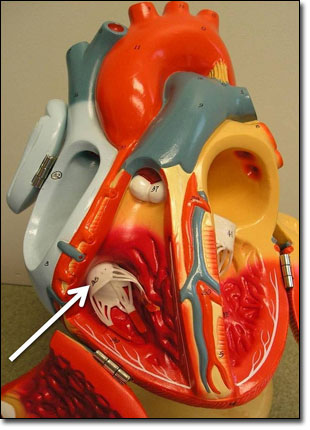One town’s high rate of elective angioplasties has drawn the attention of the California HealthCare Foundation Center for Health Reporting and the San Francisco Chronicle.

Tricuspid valve in a model heart. (Photo by robswatski via Flickr)
Emily Bazar reports that people in Clearlake, Calif., have undergone the procedure at 15 times the rate of people in nearby Sonoma County and more than five times the rate of San Franciscans and Californians. Clearlake residents had elective angiography at nearly six times the state rate.
The project includes a downloadable spreadsheet of heart surgical procedures for 208 geographic areas in California.
The analysis was done by Stanford health research and policy Professor Laurence Baker and was commissioned by “the Campaign for Effective Patient Care, an interest group that promoted the involvement of patients in making medical decisions. Formed during the Health Policy debate, the group recently disbanded.”
The financial and health implications of extreme variation are enormous, raising the prospect that billions of dollars are wasted each year on unnecessary and potentially dangerous treatments. About 600,000 angioplasties alone are performed nationwide annually at a price tag of more than $12 billion, according to a recent study in the Journal of the American Medical Association.
The analysis finds the heart procedures were performed frequently in other parts of California as well. While one hospital says the disparity is because its rural community suffers from overlapping health situations, comparing it to the Third World, the research shows that above-average use of the procedures was found in urban areas as well.
Yet long-standing research suggests that something else usually causes large geographic variation in medical procedures: striking disparities in how doctors treat diseases.
“You just have a group of physicians that tend to order more angiograms or (angioplasties). That’s how they think and do things. They’ve never been told not to. They’ve never been told they’re the outliers,” said Eric Hammelman, a vice president at Avalere Health, a health care consulting firm in Washington, D.C.
The project includes a consumer’s guide to heart procedures, graphics and an explanation of Baker’s methodology.
Learn how to use this data
In a webinar next week, Hiding in plain sight: California hospital data, Charles Ornstein, senior reporter at ProPublica and president of AHCJ’s board of directors, will guide attendees through using the data from the California Office of Statewide Health Planning and Development to determine rates of variation for types of treatments.
Ornstein calls the data set a “gold mine” that can answer questions such as:
- Does your local hospital place more cardiac stents than others?
- Do more of its patients leave the emergency room without being seen?
- Does it have a high level of C-section births?
It doesn’t matter if your hospital is public, nonprofit or for-profit, data on its patients and services are available online. Join us on Sept. 13 to learn how to use this data. California journalists will find this particularly useful, but it also introduces data sets that journalists can request in other states.




